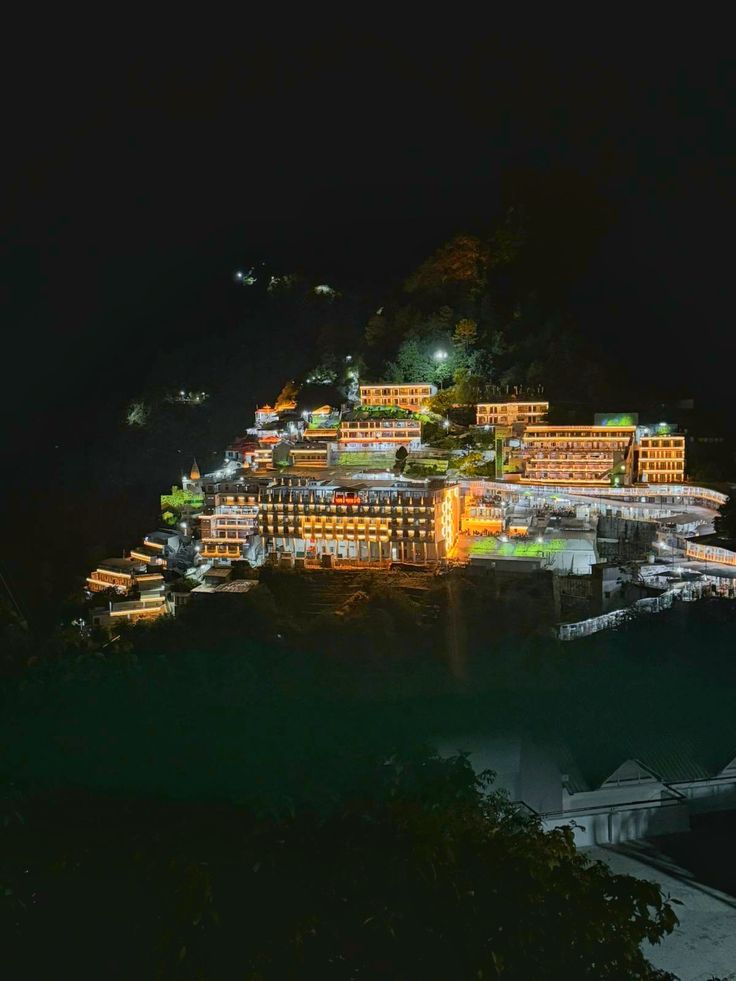Vaishno Devi: The Sacred Pilgrimage, Spiritual Significance, and Cultural Impact
Introduction
Situated in the scenic Trikuta Mountains of Jammu and Kashmir, the Vaishno Devi Temple is one of the holiest shrines in India, attracting millions of pilgrims each year. The temple is dedicated to Mata Vaishno Devi, an incarnation of Goddess Durga, and is famous for its spiritual power and divine blessings. The pilgrimage to Vaishno Devi is considered a sacred journey, a path of spiritual cleansing and divine connection. The shrine’s rich history, spiritual significance, and cultural impact make it a beacon of devotion and faith for people across the world.
1. The Legend and History
The history of Vaishno Devi is deeply rooted in Hindu mythology. It is believed that Mata Vaishno Devi was born as Vaishnavi, the incarnation of Goddess Durga, with the purpose of destroying the demon Mahishasura. According to legend, she meditated for years in the Trikuta Hills, and after intense spiritual practices, she manifested herself in the form of a cave shrine. The holy cave at Vaishno Devi is said to be the place where Mata Vaishno Devi resides in her divine form.
It is also believed that Vaishno Devi’s devotees must undergo a pilgrimage to seek her blessings. During the journey, the pilgrims are asked to follow a strict code of conduct, abstaining from food and drink, focusing only on prayers and the divine experience. The temple has been a significant spiritual center for centuries, and its history can be traced back to the Mahabharata period when Pandavas are believed to have visited the shrine.
2. Significance and Spirituality
Vaishno Devi’s shrine is one of the most revered places of pilgrimage in India, and its significance is immense in Hinduism. Devotees believe that visiting Vaishno Devi and offering prayers will result in divine blessings, spiritual purification, and protection from evil. The goddess is worshipped as the giver of peace, prosperity, and happiness. The three deities representing Mata Vaishno Devi in the cave shrine symbolize Mahalakshmi (for wealth), Mahalakshmi (for knowledge), and Maha Saraswati (for prosperity and blessings).
Pilgrims who make the journey to Vaishno Devi are believed to receive divine protection and are blessed with good health, wealth, and happiness in their lives. The temple’s sacredness has made it a center of devotion, where millions of people from different faiths and backgrounds come seeking the grace and favor of the goddess.
3. Impact on Daily Life
The journey to Vaishno Devi is a spiritual one, and it significantly impacts the daily lives of the devotees. Pilgrims, known as Yatris, embark on the trek to the temple, which involves walking for hours along a winding path up the mountain. The path, which stretches approximately 13 kilometers from the base to the shrine, is considered a spiritual test, where the journey itself is believed to purify the soul.
The daily life of a devotee during this pilgrimage is marked by devotion, discipline, and unwavering faith. Pilgrims often refrain from eating, drinking, or engaging in worldly pleasures during the journey, dedicating themselves fully to the goddess. Many chant mantras and hymns, seeking Mata Vaishno Devi’s guidance and blessings.
The pilgrimage is seen as a rite of passage, and individuals who complete the journey often report feeling spiritually awakened and deeply connected with the divine. For many, the experience of visiting Vaishno Devi and offering prayers at the holy cave brings peace of mind, renewed purpose, and inner strength.
4. Cultural and Societal Impact
It is not only significant to the followers of Hinduism but has a wider cultural impact on society. The pilgrimage is deeply ingrained in the social fabric of India, fostering unity, brotherhood, and a shared sense of spiritual purpose. The city of Katra, which serves as the base camp for the pilgrimage, has flourished due to the thousands of devotees who visit every day, contributing to the local economy.
In addition to economic benefits, the pilgrimage to Vaishno Devi also brings people from different walks of life together. It fosters a sense of community, shared faith, and compassion among individuals who may otherwise not have crossed paths. The temple’s atmosphere encourages peace and spiritual harmony, transcending religious differences and creating a sense of belonging for everyone who visits.
5. The Journey: Pilgrimage and Rituals
The pilgrimage to Vaishno Devi is a physically demanding yet deeply fulfilling journey. The trek to the temple can be challenging, with steep paths and varying weather conditions, but it is considered a rite of passage for devotees. Most pilgrims make the journey on foot, though palanquins, horses, and ponies are available for those unable to walk the entire distance.
Upon reaching the temple, devotees enter the sacred cave, where they offer prayers to Mata Vaishno Devi. The rituals at the shrine are simple but deeply meaningful, centered around humility, faith, and surrender to the divine will. Pilgrims are asked to offer a token of their love and devotion, such as a chadar (cloth), prasad, or cash donation.
The temple is open year-round, and pilgrims are encouraged to visit during auspicious occasions like Navratri, the festival dedicated to the Goddess Durga, when special prayers and celebrations are held.
6. Frequently Asked Questions (FAQs)
- What is the best time to visit?
The best time to visit Vaishno Devi is between March and October when the weather is pleasant and ideal for trekking. However, the temple remains open throughout the year. - How long does it take to complete the pilgrimage?
The pilgrimage typically takes 2 to 3 days, depending on the pilgrim’s pace and stamina. The trek from Katra to Vaishno Devi temple is about 13 kilometers, which can take anywhere from 5 to 8 hours one way. - How can I reach?
Vaishno Devi can be reached by air, rail, or road. The nearest airport is in Jammu, about 50 kilometers away from Katra, the base town. From there, pilgrims can take a taxi, bus, or even walk to the temple. - Is accessible for senior citizens or the differently-abled?
Yes, the shrine is accessible to senior citizens and differently-abled individuals, with the availability of palanquins, pony rides, and wheelchairs to assist in the journey.
7. Conclusion
It is more than just a temple—it is a journey of faith, devotion, and self-discovery. The pilgrimage to Vaishno Devi is a transformative experience that deeply impacts the lives of those who undertake it. The temple’s spiritual significance, the dedication of the pilgrims, and the cultural impact it has on society make it an important symbol of faith, devotion, and unity.
Whether you are seeking spiritual enlightenment, inner peace, or divine blessings, the sacred journey to Vaishno Devi will undoubtedly leave a lasting impression, inspiring you to live a life of purpose, faith, and devotion.










